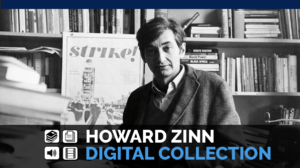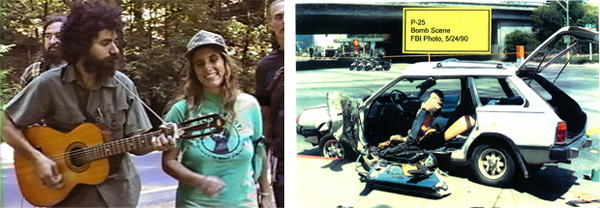
Judi Bari was a fighter and organizer for many labor, social, and environmental justice causes. Many think it was her efforts to build alliances between timber workers and environmentalists that brought her to the attention of timber company executives and made her the target of efforts to smear and discredit Earth First!
On May 24, 1990, Bari and Darryl Cherney were on a concert and speaking tour to recruit college students for Redwood Summer (inspired by Freedom Summer), a campaign of nonviolent mass protests against corporate liquidation logging. While driving through Oakland, California, a motion-triggered pipe bomb wrapped with nails exploded directly under her driver’s seat. Instead of investigating the bombing as attempted murder, the FBI tried to frame Bari and Cherney for the bombing. According to Bari and Cherney’s lawyers, this was a “deliberate, politically motivated effort to target and ‘neutralize’ Judi, Darryl, and Earth First!, and to discourage people from traveling from all over the nation to join in Redwood Summer. The sensational false charges made headlines nationwide, and the FBI and their Oakland Police accomplices kept a two-month media smear campaign going with a series of false claims about physical evidence linking Judi to building the bomb.”
In April 2001, Howard Zinn wrote a letter to civil rights lawyer Dennis Cunningham offering to provide expert testimony in the civil case regarding the FBI’s history of using the Counterintelligence Program—COINTELPRO. Below is a transcript of his letter to the lead counsel. [Summary adapted from JudiBari.com and I.W.W.org.]
View a PDF of “Plaintiffs’ Offer of Proof Regarding FBI Misconduct” that includes Zinn’s letter.
Watch a trailer for The Forest For The Trees, a documentary about this court case directed by Bernadine Mellis, Cunningham’s daughter who documented the trial.
___________________________________________________
Howard Zinn
Auburndale, MA 02466
April 30, 2001
Dear Mr. Cunningham:
It is my considered opinion, knowing of the car bomb explosion which injured Judi Bari and Darryl Cherney in 1990, and knowing of their speedy subsequent arrest on sensational criminal charges, that the apparent ‘frame-up’ of the two as supposed bombers — as reflected in the evidence described in the “big brief” from Bari v. USA — is consistent with the history of the Federal Bureau of Investigation. That history, for many years before 1990, and continuing after that, shows that the FBI has repeatedly attempted to harass, injure, even cause the death of individuals in order to disrupt the activities of organizations critical of government and the Establishment.
That history indicates that in the pursuit of this disruption, the FBI has again and again violated the constitutional rights of Americans, including their right to freedom of speech and freedom of association. It indicates that the FBI would have been ready, willing and able to pervert the Constitution, and their own law enforcement responsibility under it, in the ways the plaintiffs allege, in the attempt to discredit and “neutralize” a movement like Earth First! and other allied forces working to preserve and protect the environment.
The most powerful evidence for my claim, buttressing my opinion, is in the government’s own documents, chiefly the Final Report of the Select Committee to Study Governmental Operations With Respect to Intelligence Activities, of the United State Senate, published in 1976 by the Government Printing Office (informally known as the Church Committee).
That report details the covert activities of COINTELPRO (standing for Counterintelligence Program), an FBI program designed, as the Committee report says, to “disrupt” and “neutralize” target groups and individuals. The Church committee’s report was based, it says, on a staff study of more than 20,000 pages of Bureau documents, depositions of many of the Bureau agents involved in the programs, and interviews of several COINTELPRO agents.
COINTELPRO began in 1956 “in part because of frustration with Supreme Court rulings limiting the Government’s power to proceed overtly against dissident groups” and was claimed to have ended in 1971, the committee report says, “with the threat of public exposure.” That the FBI tactics, violating constitutional rights, described in the committee report, was not confined to those years, is clear from what it was doing before 1956 and after 1971, so that its actions against Judi Bari and Earth First in 1990 do not represent a departure from its history.
The violations of constitutional rights go back to the first World War, when the long-time, powerful head of the FBI, J. Edgar Hoover, was in charge of the Bureau of Investigation, predecessor to the FBI. According to the FBI’s own document, quoted in the Church committee report (p. 381) there was a “mass deprivation of rights incident to the deserter and selective service violator raids in New York and New Jersey in 1918…” What happened is that 35 Bureau Agents assisted by police and military personnel and a “citizens auxiliary” of the Bureau, “rounded up some 50,000 men without warrants of sufficient probable cause for arrest.”
In 1920 the Bureau, along with Immigration Bureau agents, carried on the “Palmer Raids” (authorized by Attorney General A. Mitchell Palmer), which, in 33 cities rounded up 10,000 persons. The Church Committee report (p.384) talks of “the abuses of due process of law incident to the raids,” quoting a scholarly study (Robert Preston, Aliens And Dissenters) that these raids involved “indiscriminate arrests of the innocent with the guilty, unlawful seizures by federal detectives…” and other violations of constitutional rights.
The Church committee (p.385) cites a report of distinguished legal scholars (Roscoe Pound, Felix Frankfurter and others) made after the Palmer Raids, and says the scholars “found federal agents guilty of using third-degree tortures, making illegal searches and arrests, using agents provocateurs….”
When in 1924, Harlan Fiske Stone became Attorney General, he succeeded in temporarily halting the unconstitutional activities of the Bureau, saying: “When a police system passes beyond these limits [conduct forbidden by law] it is dangerous to the proper administration of justice and to human liberty.” (quoted in Morton Halperin et al, The Lawless State, p. 95)
World War II brought a return of the FBI to counterintelligence operations as President Franklin D. Roosevelt in a 1940 memorandum gave the FBI the power to use warrantless wiretaps against suspected subversives. This was contrary to a Supreme Court decision of 1937 (Nardone v. U.S.) saying that a Congressional statute making it a crime for “any person” to intercept wire communications applied to federal agents also.
COINTELPRO developed out of the anti-Communist hysteria of the cold war years, but led to FBI actions against groups that had nothing to do with Communism. The Church committee reports that COINTELPRO, presumably set up to protect national security and prevent violence, actually engaged in other actions “which had no conceivable rational relationship to either national security or violent activity. The unexpressed major premise of much of COINTELPRO is that the Bureau has a role in maintaining the existing social order, and that its efforts should be aimed toward combating those who threaten that order.” (p.7)
This meant that the Bureau would take actions against individuals and organizations simply because they were critical of government policy. The Church committee report gives examples of such actions, violations of the right of free speech and association, where the FBI targeted people because they opposed U.S. foreign policy, or criticized the Chicago police actions at the 1968 Democratic National Convention. The documents assembled by the Church committee “compel the conclusion that Federal law enforcement officers looked upon themselves as guardians of the status quo” and cite the surveillance and harassment of Martin Luther King Jr. as an example of this. (p.7)
The report quotes former Assistant to Director Hoover, William C. Sullivan: “This is a rough, tough, dirty business, and dangerous….No holds were barred.” The Church committee says: “In the course of COINTELPRO’s fifteen year history, a number of individual actions may have violated specific criminal statutes, a number of individual actions involved risk of serious bodily injury or death to the targets (at least four assaults were reported as ‘results’….)”
Was that “rough, tough, dirty business” confined to the official life-span of COINTELPRO (1956 to 1971)? The Church committee’s report discusses this question. “If COINTELPRO had been a short-lived aberration, the thorny problems of motivation, techniques, and control presented might be safely relegated to history. However, COINTELPRO existed for years on an ‘ad hoc’ basis before the formal programs were instituted, and more significantly, COINTELPRO-type activities may continue today under the rubric of ‘investigation.'” (p.12)
The Church committee cites the testimony in 1975 of FBI director Clarence M. Kelley as indication that even after the official end of COINTELPRO, “faced with sufficient threat, covert disruption is justified.” (p. 14)
The FBI continued to violate the constitutional rights of citizens through the 1980’s, up to 1990, as revealed by Ross Gelbspan in his book Break-Ins, Death Threats and The FBI. Utilizing thousands of pages of FBI documents secured through the Freedom of Information Act, Gelbspan found that activists who opposed U.S. policy in Central America “experienced nearly 200 incidents of harassment and intimidation, many involving…break-ins and thefts or rifling of files.” (p.1) Gelbspan’s intent was to “add a small document to the depressingly persistent history of the FBI as a national political police force.” The Bureau’s proper function is to catch criminals, he points out in his book. When it operates as a political police “it is an affront to the basic rights of free speech and association and an insult to the letter and the spirit of the Constitution.”
From all this and more, as my study continues, it seems clear that the history of the FBI is consistent with the charges that it sought to discredit and “neutralize” Judi Bari and Darryl Cherney, and the environmental cause they were working for, by smearing them publicly with sensational false charges of possession of a bomb, and that it did not hesitate to violate their constitutional rights to achieve its ends.
My sources for the above include the report of the Church Committee, and the other works cited; in addition, I would point out the following books:
- David J. Garrow, The FBI and Martin Luther King, Jr. (1981);
- William Turner, Hoover’s FBI (1971);
- Joseph Schott, No Left Turns; The FBI in Peace and War (1975);
- Don Whitehead, The FBI Story (1951);
- Sanford Unger, FBI (1975);
- Max Lowenthal, The FBI (1950).
I am Professor Emeritus of Political Science, Boston University. I plan to serve pro bono in this case. I haven’t testified in any case, as expert or otherwise, for several years. Attached is a biographical summary of my academic career and my writings.
Sincerely,
Howard Zinn
The Forest For The Trees TRAILER
This film documents the civil case led by lawyer Dennis Cunningham (Jan. 2, 1936–March 5, 2022) representing Judi Bari and Darryl Cherney. Cunningham was a civil rights lawyer involved in cases of activists including Fred Hampton, the Weathermen, logging protesters, and the Attica Brothers Legal Defense Fund. In this clip, Cunningham states, “There’s a great political question in any system: Quiesce custodiet? Whatever the Latin is, the question is who guards the guardians? Who’s gonna police the police? If the police do wrong and the prosecutor won’t do anything about it then it’s up to the person who’s wrong to bring a case in the civil court to enforce their rights.”
Related RESOURCES
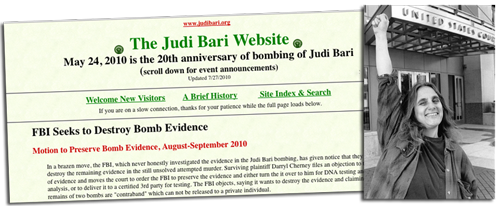 Judi Bari Website
Judi Bari Website
Learn more about the Judi Bari and Michael Cherney case at www.judibari.org.
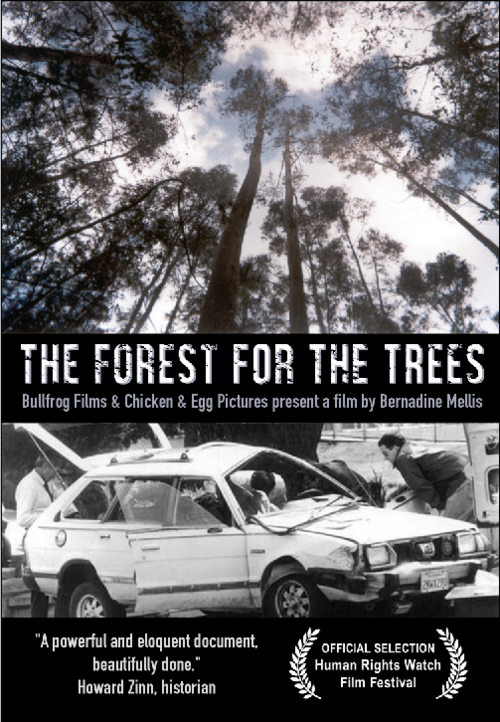 The Forest for the Trees
The Forest for the Trees
Filmmaker Bernadine Mellis, daughter of lawyer Dennis Cunningham who is representing Judi Bari and Darryl Cherney, documents the trial. Mellis is at strategy meetings, at breakfast, driving to and from the court, documenting her morally driven, very tired dad. The Forest for the Trees offers access into a unique father-daughter relationship, the painfully short yet extraordinary life of Judi Bari, and a piece of U.S. history that everyday grows increasingly resonant as once again the lines between dissent and terrorism are being intentionally blurred. www.bullfrogfilms.com/catalog/fftthv.html
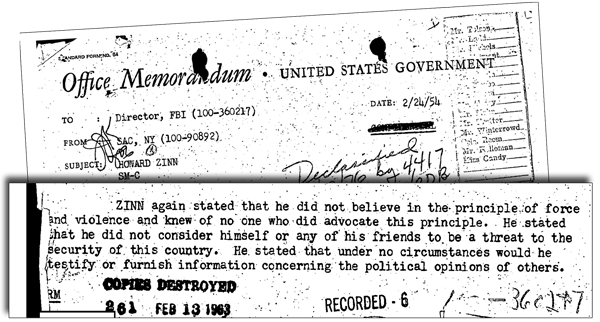 First FBI Interview with Howard Zinn
First FBI Interview with Howard Zinn
In July 2010, the FBI declassified 243-page file on Howard Zinn, dating back to 1949. The first recorded contact with Zinn is this report filed four years later on November 25, 1953. Two FBI agents questioned Zinn about matters based on information provided by informants. FBI files on individuals and groups are notoriously unreliable. They are shared here simply as relevant primary documents. Transcript of this file follows. Continue reading.
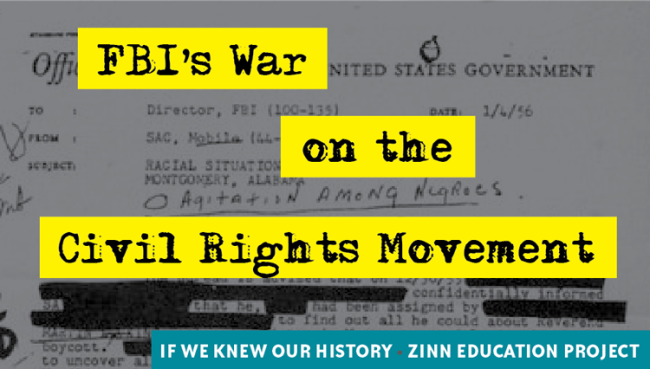 Why We Should Teach About the FBI’s War on the Civil Rights Movement
Why We Should Teach About the FBI’s War on the Civil Rights Movement
By Ursula Wolfe-Rocca. A 1971 break-in at FBI offices revealed a conspiracy—known as COINTELPRO—for the FBI to infiltrate, disrupt, and destroy a wide range of activist groups, especially civil rights organizations. Textbooks ignore this chapter in U.S. history, but it’s essential background to understand what’s happening today. Read more.

